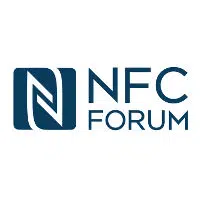The NFC Forum has released a new candidate specification that makes it easy for mobile payments services based on QR codes to add NFC functionality, giving “payment service providers and consumers the opportunity to take advantage of the simple and secure NFC-based payment solutions already in use worldwide.”
 The NFC Money Transfer Candidate Specification (NMT) provides a way to embed QR code data in a standard NDEF record, opening up the possibility for an NFC phone to be used to read an NDEF version of a merchant’s static QR code embedded in a simple NFC sticker — and even, eventually, for a QR payment service to be supported on standard contactless POS devices.
The NFC Money Transfer Candidate Specification (NMT) provides a way to embed QR code data in a standard NDEF record, opening up the possibility for an NFC phone to be used to read an NDEF version of a merchant’s static QR code embedded in a simple NFC sticker — and even, eventually, for a QR payment service to be supported on standard contactless POS devices.
Because the new NMT specification is based around NDEF messages, which are supported by Apple, both Android and iOS device owners are expected to be able to make use of NMT services, Paula Hunter, executive director of the NFC Forum, told NFC World.
“The NFC Money Transfer Specification provides an open platform similar to the platform described by the Connection Handover Specification for pairing of Bluetooth and WiFi devices,” Juergen Boehler, chair of the NFC Forum Technical Committee, explains.
“Therefore I am convinced that the NFC Money Transfer Specification has the same potential to simplify the payment transactions like NFC did for pairing of Bluetooth and WiFi.”
Simple
NMT “enables the transfer of money either between two persons or between a person and a merchant,” STMicroelectronics’ Daniel Orsatti adds. “The idea is to have a very simple way to do it by just using an app.
“The starting point was to define an NFC solution able to replace existing QR code solutions in Asia which require additional actions from the user to pre-select the right payment app and then to activate and place the camera in the correct position.
“Once the development process was started it quickly became apparent that there was an even greater need for an NFC solution. We have enlarged the specification’s scope to not only cover Asia use cases but to offer a generic framework covering payment systems.”
“Today, many payment systems in the market allow you to pay with QR code solutions, especially with small amounts of money,” Orsatti says. “These payment solutions can be easily replaced by NMT as the same data exchange can be implemented with NFC communication.
“The difference is that NFC brings the advantage of an even faster payment transaction and an even more convenient payment solution as the user does not need to select the right payment app, activate the camera and hold it in exactly the right position to use it. With NMT the selection of the right payment application is done automatically.
“Another use case could, for example, be the situation where one person wants to transfer to his or her friend some money. With NMT, by simply tapping their phones the payment app is selected and the transaction is executed. The protocol further allows the transaction to be initiated either by the payer (‘I transfer you this amount’) or by the payee (‘transfer me this amount’).”
Security
“Using NFC smartphones, millions of consumers around the world pay merchants quickly, conveniently, and safely,” adds Matthew Bright, chair of the NFC Forum’s Retail & Payment SIG.
“There are also millions more who transfer money using visual codes that lack the security and convenience we’ve come to associate with NFC. Fortunately, as NFC is available on more phones than ever, there are immediate opportunities to improve those visual code-based payment systems with simple, secure, and interoperable money transfer transactions based on NFC.
“The NFC Forum’s new NFC Money Transfer candidate specification provides a framework that makes it easier than ever for payment apps to develop interoperable solutions that bring the convenience and security of NFC beyond traditional card payments and into the vast landscape of person-to-person transactions.”